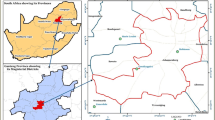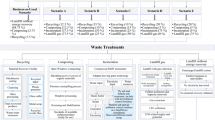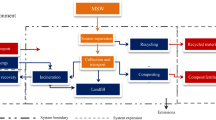Abstract
Background
This article describes two projects conducted recently by Sound Resource Management (SRMG) – one for the San Luis Obispo County Integrated Waste Management Authority (SLO IWMA) and the other for the Washington State Department of Ecology (WA Ecology). For both projects we used life cycle assessment (LCA) techniques to evaluate the environmental burdens associated with collection and management of municipal solid waste. Both projects compared environmental burdens from curbside collection for recycling, processing, and market shipment of recyclable materials picked up from households and/or businesses against environmental burdens from curbside collection and disposal of mixed solid waste.
Method
logy. The SLO IWMA project compared curbside recycling for households and businesses against curbside collection of mixed refuse for deposition in a landfill where landfill gas is collected and used for energy generation. The WA Ecology project compared residential curbside recycling in three regions of Washington State against the collection and deposition of those same materials in landfills where landfill gas is collected and flared. In the fourth Washington region (the urban east encompassing Spokane) the WA Ecology project compared curbside recycling against collection and deposition in a wasteto- energy (WTE) combustion facility used to generate electricity for sale on the regional energy grid. During the time period covered by the SLO study, households and businesses used either one or two containers, depending on the collection company, to separate and set out materials for recycling in San Luis Obispo County. During the time of the WA study households used either two or three containers for the residential curbside recycling programs surveyed for that study. Typically participants in collection programs requiring separation of materials into more than one container used one of the containers to separate at least glass bottles and jars from other recyclable materials. For the WA Ecology project SRMG used life cycle inventory (LCI) techniques to estimate atmospheric emissions of ten pollutants, waterborne emissions of seventeen pollutants, and emissions of industrial solid waste, as well as total energy consumption, associated with curbside recycling and disposal methods for managing municipal solid waste. Emissions estimates came from the Decision Support Tool (DST) developed for assessing the cost and environmental burdens of integrated solid waste management strategies by North Carolina State University (NCSU) in conjunction with Research Triangle Institute (RTI) and the US Environmental Protection Agency (US EPA)1. RTI used the DST to estimate environmental emissions during the life cycle of products. RTI provided those estimates to SRMG for analysis in the WA Ecology project2. For the SLO IWMA project SRMG also used LCI techniques and data from the Municipal Solid Waste Life- Cycle Database (Database), prepared by RTI with the support of US EPA during DST model development, to estimate environmental emissions from solid waste management practices3. Once we developed the LCI data for each project, SRMG then prepared a life cycle environmental impacts assessment of the environmental burdens associated with these emissions using the Environmental Problems approach discussed in the methodology section of this article. Finally, for the WA study we also developed estimates of the economic costs of certain environmental impacts in order to assess whether recycling was cost effective from a societal point of view.
Conclusions
Recycling of newspaper, cardboard, mixed paper, glass bottles and jars, aluminum cans, tin-plated steel cans, plastic bottles, and other conventionally recoverable materials found in household and business municipal solid wastes consumes less energy and imposes lower environmental burdens than disposal of solid waste materials via landfilling or incineration, even after accounting for energy that may be recovered from waste materials at either type disposal facility. This result holds for a variety of environmental impacts, including global warming, acidification, eutrophication, disability adjusted life year (DALY) losses from emission of criteria air pollutants, human toxicity and ecological toxicity. The basic reason for this conclusion is that energy conservation and pollution prevention engendered by using recycled rather than virgin materials as feedstocks for manufacturing new products tends to be an order of magnitude greater than the additional energy and environmental burdens imposed by curbside collection trucks, recycled material processing facilities, and transportation of processed recyclables to end-use markets. Furthermore, the energy grid offsets and associated reductions in environmental burdens yielded by generation of energy from landfill gas or from waste combustion are substantially smaller then the upstream energy and pollution offsets attained by manufacturing products with processed recyclables, even after accounting for energy usage and pollutant emissions during collection, processing and transportation to end-use markets for recycled materials. The analysis that leads to this conclusion included a direct comparison of the collection for recycling versus collection for disposal of the same quantity and composition of materials handled through existing curbside recycling programs in Washington State. This comparison provides a better approximation to marginal energy usage and environmental burdens of recycling versus disposal for recyclable materials in solid waste than does a comparison of the energy and environmental impacts of recycling versus management methods for handling typical mixed refuse, where that refuse includes organics and non-recyclables in addition to whatever recyclable materials may remain in the garbage. Finally, the analysis also suggests that, under reasonable assumptions regarding the economic cost of impacts from pollutant emissions, the societal benefits of recycling outweigh its costs.
Similar content being viewed by others
Author information
Authors and Affiliations
Corresponding author
Rights and permissions
About this article
Cite this article
Morris, J. Comparative LCAs for Curbside Recycling Versus Either Landfilling or Incineration with Energy Recovery (12 pp). Int J Life Cycle Assessment 10, 273–284 (2005). https://doi.org/10.1065/lca2004.09.180.10
Received:
Accepted:
Published:
Issue Date:
DOI: https://doi.org/10.1065/lca2004.09.180.10




